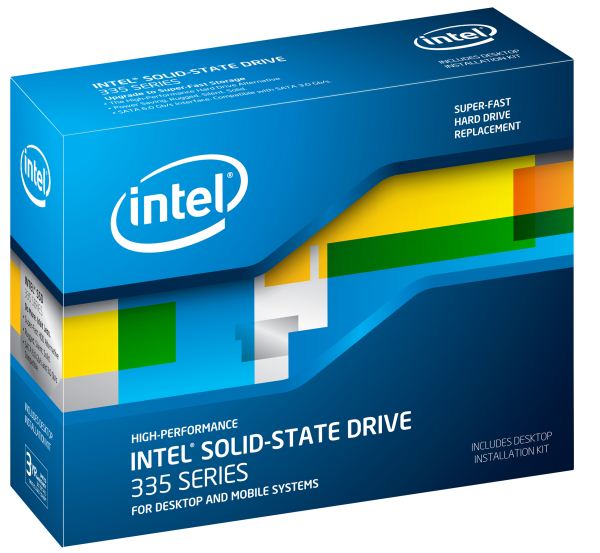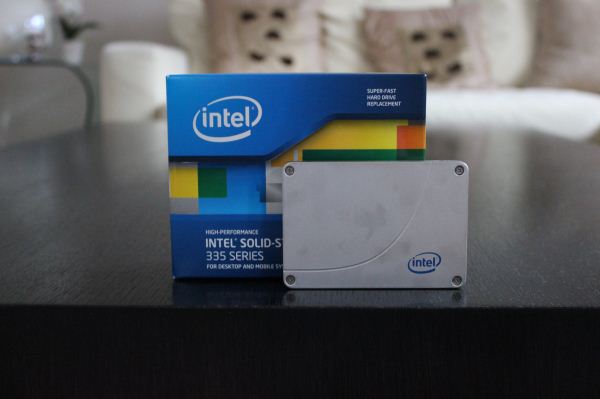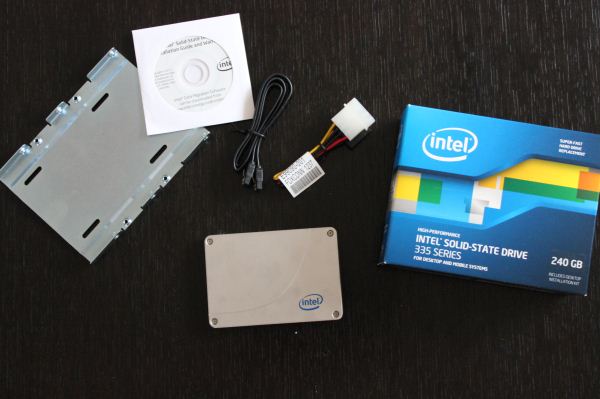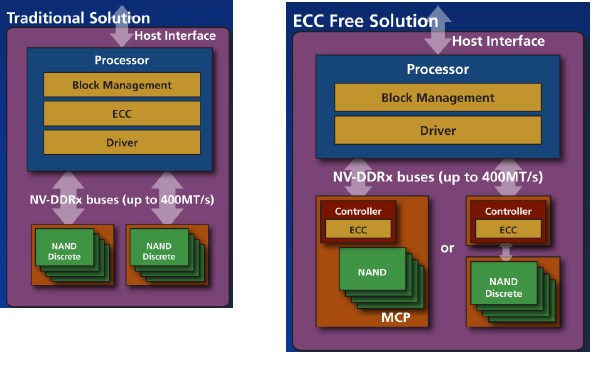Intel SSD 335 (240GB) Review
by Kristian Vättö on October 29, 2012 11:30 AM ESTIntroduction
Back in February, Intel released its first SandForce based SSD: the Intel SSD 520. Since then Intel's SSD lineup has evolved. A couple of months after the 520's release, Intel released a more mainstream focused SSD 330. Architecturally the SSD 520 and 330 were the same as both used SandForce's SF-2281 controller and IMFT's MLC NAND. The only real differences were limited to NAND quality and firmware; the 520 used higher binned NAND with more P/E cycles and its firmware was also more finely tuned to provide better performance.
While SandForce has yet to release its 3rd generation SSD controller, there's still room to upgrade one major component of these drives: the NAND itself. IMFT (Intel's and Micron's NAND joint-venture) has been fairly open about its next generation NAND products, including the transition to 20nm MLC NAND. Moving to smaller process geometries decreases die area, which increases the number of NAND die that can be produced on a single wafer (or increases the capacity that can reliably be produced on a single die). The move to 20nm is a necessary part of continuing to drive SSD costs down, although as with all process transitions we won't see those cost savings initially (die savings are offset by higher costs of a new process at the start).
IMFT's 20nm announcement happened back in April 2011. At the time, we were told not to expect to see 64Gb 20nm MLC NAND devices in SSDs until the middle of 2012. Now, a year and a half later, production is finally at a stage where volume and yields are both high enough for an actual product release. The vehicle for introduction? Intel's SSD 335.
As the name already suggests, the 335 is not a major upgrade over the 330. Intel usually reserves XX0 product names for bigger upgrades, such as the SSD 520 update where Intel moved to SandForce from a Marvell controller that was used in the SSD 510. The more minor updates (usually NAND die shrinks) only change the last number of the model. In other words, SSD 335 is essentially the SSD 330 but with 20nm MLC NAND instead of 25nm MLC NAND. Below is a full comparison of Intel's current consumer SSDs:
| Comparison of Intel's Consumer SSDs | |||
| SSD 330 (240GB) | SSD 335 (240GB) | SSD 520 (240GB) | |
| Capacities (GB) | 60, 120, 180, 240 | 240 | 60, 120, 180, 240, 480 |
| Controller | SandForce SF-2281 | ||
| NAND | Intel 25nm MLC | Intel 20nm MLC | Intel 25nm MLC |
| Sequential Read | 500MB/s | 500MB/s | 550MB/s |
| Sequential Write | 450MB/s | 450MB/s | 520MB/s |
| 4KB Random Read | 42K IOPS | 42K IOPS | 50K IOPS |
| 4KB Random Write | 52K IOPS | 52K IOPS | 80K IOPS |
| Warranty | 3 years | 3 years | 5 years |
At first, the SSD 335 will only be available in a 240GB capacity. I suspect that this has to do with 20nm NAND yields and volumes; it's a new process, yields are obviously lower and Intel hasn't had time to build an enormous stock yet. By only releasing a 240GB model at this point, which Intel tells us is the most popular capacity, it makes sure the 240GB model should be available in sufficient volume for the holiday market. If Intel had released all capacities simultaneously, it's possible that some capacities would have ran out of stock quickly. Intel likely still has a decent stock of 25nm NAND, so the 330 will stick around for at least a few months while the 335 ramps up additional capacities. The Intel SSD 520 will still be available as well, although I'm hearing that its successor is coming soon.
In terms of performance, the SSD 330 and SSD 335 are similar. This isn't shocking given that they are both based on the same controller and the only difference is the move from 25nm to 20nm MLC NAND. We aren't going to see any significant improvements in SandForce based SSDs until the third generation (SF-3000) controllers become available, which should be some time next year. There have of course been minor modifications to the firmware to support 20nm MLC NAND.
Similar to the SSD 330, the SSD 335 comes with a desktop installation kit including a 2.5" to 3.5" adapter, SATA cable and a Molex to SATA power adapter.
| NewEgg Price Comparison (10/29/2012) | ||||
| Capacity | 60/64GB | 120/128GB | 240/256GB | 480/512GB |
| Intel SSD 335 | N/A | N/A | $184 (MSRP) | N/A |
| Intel SSD 330 | $70 | $99 | $190 | N/A |
| Intel SSD 520 | $95 | $120 | $240 | $490 |
| Crucial m4 | $75 | $110 | $200 | $390 |
| Samsung SSD 830 | $100 | $85 | $170 | $530 |
| Samsung SSD 840 | N/A | $110 | $200 | $450 |
| Plextor M5S | $65 | $120 | $200 | N/A |
| OCZ Vertex 4 | $75 | $100 | $200 | $400 |
| Corsair Neutron | N/A | $130 | $220 | N/A |
Intel's target with the SSD 330 was to bring an affordable drive to the market and the SSD 335 continues this trend. Suggested retail price of $184 for a 240GB drive is very competitive and there aren't many drives that can beat that at the moment.
Update: The 240GB SSD 335 is already available in NewEgg for $210, which is unfortunately over $20 more than what the MSRP suggested.
The NAND
Intel's 20nm MLC NAND is mostly the same as its 25nm MLC NAND. We are still looking at 8GB per die with an 8KB page size, although Intel does have a 16GB die in development which will also increase the page size to 16KB. Since the key aspects are the same, there haven't been any dramatic changes to performance. Intel wouldn't provide us with any specific numbers but program latency is the same and erase time is slightly longer than its 25nm MLC NAND.
The new NAND also enables ONFI 2.3 support. ONFI 2.3 doesn't bring any bandwidth improvements as the spec still maxes out at 200MB/s. IMFT's 16GB die will feature ONFI 3.0 support, bringing the maximum bandwidth between the controller and NAND to 400MB/s per channel. The biggest new feature in ONFI 2.3 is support for the EZ-NAND protocol, although Intel has not adopted this protocol to its NAND. EZ-NAND allows ECC to be offloaded from the SSD controller to a separate controller (can be integrated into the NAND package as well):
Normal NAND on the left - EZ-NAND on the right
The advantage of offloading the ECC from the controller is that now ECC can be updated along with NAND without the need for a new controller. ECC is strictly implemented in hardware, which means a firmware update doesn't help; you will need a new physical controller to update ECC. As we move to smaller process nodes, the need for ECC increases as the error rate goes up. With more error prone NAND, it becomes even more important to decouple ECC generations from the host controller since the same controller can be used for more than one NAND generation. In the Intel SSD 335, ECC is still handled by the SF-2281 controller but in theory, manufacturers using Intel NAND could implement a third party off-chip ECC controller in their SSDs.














69 Comments
View All Comments
MichaelD - Tuesday, October 30, 2012 - link
I agree! Take Corsair for example; they've got like a hundred (sic) different SKU's. "Force" "Subforce" "Battle" "Skeedaddle" and "Primo" versions of SSDs...marketing FUD at it's finest. Only the .5% of SSD buyers (like AT readers) will actually look at specs and decide. The other 99.5% will just buy whatever box has the "fastest looking" cover art.zanon - Monday, October 29, 2012 - link
Now they just get giggle-stomped across the board by Samsung. I hope Intel decides to be competitive again someday, but in the mean time it's hard to see any reason to bother.MadMan007 - Monday, October 29, 2012 - link
Read past the sythetics to real-world tests. It is at least competitive in most cases, and all these drives are stupid fast anyway.jeffbui - Monday, October 29, 2012 - link
Why is there such a discrepancy between the power consumption figures given by the manufacturer vs what you're getting from your testing? (Samsung mostly) Other websites are getting completely different power usage figures as well.DanNeely - Monday, October 29, 2012 - link
Comments on one of AT's other recent SSD articles claimed this is because the power consumption test is being done using an external enclosure that never lets the drive drop into it's lowest power states. I didn't see any official comment on it.Kristian Vättö - Monday, October 29, 2012 - link
Some manufacturers such as Samsung report their power numbers with DIPM/HIPM (Device/Host Initiated Link Power Management) enabled, which can lower the power consumption significantly. DIPM/HIPM are not enabled on desktop by default and I'm not sure if all laptops have them enabled either.We have ran tests with DIPM/HIPM enabled and gotten results similar to what manufacturers report, but so far we have kept on publishing numbers with DIPM/HIPM disabled. We will probably add DIPM/HIPM numbers once we redo our SSD testing methodology.
DanNeely - Monday, October 29, 2012 - link
If available, would the feature be called DIPM/HIPM in our bios's; or is it likely to be obfuscated to something else?Also, why is it often disabled by default? Is there a penalty related to enabling it?
Kristian Vättö - Monday, October 29, 2012 - link
Here are instructions for enabling DIPM/HIPM:http://www.sevenforums.com/tutorials/177819-ahci-l...
In desktops it's not as important because you aren't running off of a battery and the power that SSDs/HDs use is so little anyway that it won't affect your power bill. I'm not sure why it's disabled, though, because I havent heard of any concrete issues caused by it.
Per Hansson - Monday, October 29, 2012 - link
Actually I'm not sure that DIPM/HIPM is the whole reason.I mentioned it previously and it for sure can have a dramatic difference.
But just as important is the measuring equipment used for the power consumption.
A cheap DMM only measures in very slow intervals, you would get very different results when measuring using a $100 Fluke vs a $1000 Fluke vs a Scope with really high bandwidth.
It's because the SSD changes power levels many hundred times per second and this is too fast for a regular DMM so you just get some of the data points, not enough to make a reliable averge...
MrSpadge - Monday, October 29, 2012 - link
Wouldn't the slower / cheaper DMM measure over longer intervals (that's why it's slow in the first place) and hence automatically average over some fluctuation?